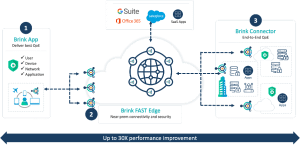The need for Enterprises to provide remote access for knowledge workers has never been greater. The rise of hybrid working has significantly increased the number of people who need to access business IT systems and applications from outside the office. Some of this increase has been offset by the switch to Cloud-based application delivery and SaaS app use in general. But many business applications still run in private data centers, and people need to be able to access them wherever they happen to be working.
The traditional approach means they need remote access to the corporate LAN to access apps and IT systems as if they were in the office. Obviously, this access must be secure, easy to use, provide connectivity, and be compatible with the endpoint devices and Enterprise systems in use. Traditionally, VPN solutions provided this access, but these were not designed for the hybrid world that many Enterprises now operate within.
Limitations of Traditional Approaches
Several limitations of traditional VPN solutions often combine to deliver a poor user experience for remote workers. The wireless networks the users are connected through can be inadequate with respect to both VPN quality and bandwidth. The same is often true for wired home broadband, where there is often network contention on the local loop. This poor connectivity often extends throughout all office hours due to the number of people who now work remotely.
Another limitation of traditional VPNs (and the increasingly popular ZTNA solutions) comes from the necessary security protocols added to the connection setup and traffic flows. This security introduces delays that negatively impact users' quality of experience. It results in slower application use, frustrated users, and lost productivity.
Many branch offices have adopted SD-WAN technologies to improve the quality of service for remote offices using the optimal network connectivity available at any particular time: Broadband, Wireless, or Mobile 5G & 4G. But the switch to hybrid working means that staff or often not in branch offices either, but rather at other locations such as homes, hotels, coffee shops, etc., where it is not practicable to deploy a traditional SD-WAN network router.
For home users, many businesses provide dedicated VPN routers for use on home broadband. If you are using a home device like Cisco Meraki VPN to try and deliver better VPN remote access for home users, it is highly likely that many are still reporting performance issues due to the inherent problems with networks and Internet providers.
Cloudbrink Hybrid Access-as-a-Service (HAaaS) is designed and built from the ground up to address and overcome the limitations outlined above. HAaaS provides cutting-edge connectivity for the modern hybrid workforce, no matter where they are in the world. Using AI and ML technology, we provide unique hybrid access that is optimized for edge-native performance. This means users can enjoy lightning-fast speeds for cloud, SaaS, and data center applications, irrespective of their location.
ZTNA and AMTD
Additionally, the software-only solution includes the world's first high-performance ZTNA, as well as personal SD-WAN and Moving Target Defense (MTD) security for hybrid and fully remote users. By utilizing thousands of dynamic Points of Presence (PoPs) called FAST (Flexible, Autonomous, Smart, and Temperal) edges in Cloud datacenter around the globe, Cloudbrink delivers an in-office equivalent experience with a 30x increase in application performance for remote workers. Best of all, this powerful experience is easy to manage by network, security, and IT administrators, with simplified operations across the board.
Bottom line: in-office performance and security for anyone, anywhere. Delivering an experience for remote workers that increases productivity and reduces the stress levels associated with trying to work via a poor network connection.
The Advantages of Cloudbrink HAaaS
Cloudbrink HAaaS is a software-only Personal SD-WAN solution that turns any internet connection into a secure and QoE-enabled link that 'just works' for end users. HAaaS replaces legacy VPN, ZTNA, and SD-WAN connectivity architectures and uses machine learning-based connectors deployed across multiple global cloud regions. These monitor local and regional network congestion and connectivity to route packets for business apps over the best network route available at that time. The network route will always be the fastest at each particular moment to deliver the optimal QoE for the end user. This is especially beneficial for bandwidth-intensive apps like video conferencing. Cloudbrink HAaaS eliminates the typical pixelation and audio dropout issues that often happen with current remote networking solutions.
The architecture of the Cloudbrink solution uses commercial access networks and multiple cloud providers and comprises of three components:
1) Brink App (downloaded onto the client device),
2) Brink FAST Edge (invisible infrastructure), and
3) Brink Connector (optional connector for data centers).
How they interact is shown schematically in the following diagram.

Figure1: Cloudbrink HAaaS architecture
The Brink Protocol provides the core technology that allows these three components to communicate.
HAaaS builds on changes that were already underway in enterprise usage patterns, including cloud adoption, SaaS consumption, and multi-cloud. But it moves on from a world where these technologies were designed with office workers in mind, extending them to reflect the new hybrid reality most organizations now face.
